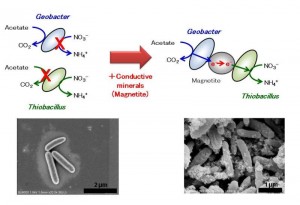Microbial electric syntrophy accelerates conversion of chemicals


Geobacter and Thiobacillus coexisting by electron transfer through magnetite ©Soichiro Kato
Theobacillus is much larger than Geobacter. It is thought that electricity flows between cells through magnetite particles which adhere to both.
Prof. Kazuhito Hashimoto at the Department of Applied Chemistry in the Graduate School of Engineering has been studying microbial fuel cells (MFCs), future clean-energy technologies in collaboration with the Japan Science and Technology Agency and Tokyo University of Pharmacy and Life Sciences. MFCs are expected to be applied to biomass/electricity-conversion processes and energy-saving water-treatment processes, and have been actively studied worldwide. However, why microbes have the ability to transfer electrons to electrodes in MFCs has remained unknown.
Prof. Hashimoto’s group hypothesized that electrodes and wires also exist in the natural environment, and microbes use them to transfer electrons between each other. In order to address this possibility, the researchers established binary cultures of model soil bacteria (Geobacter and Thiobacillus) in the presence of conductive iron-oxide (magnetite) particles, and found that magnetite substantially (over 10 fold) accelerated their cooperative catabolism. This indicates that electrons are transferred through magnetite particles, facilitating the connection of their metabolisms.
The environment consists of a huge diversity of microbes, which probably establish complex interspecies interactions. However, since microbiology has been developed based on Pasteur’s techniques of isolation and pure culture, knowledge of interspecies interaction is quite limited. Our finding will have a broad impact on our understanding of microbial interspecies interactions in nature and serve as a base for strategies for developing more efficient bioenergy processes.
Kato S., Hashimoto K., Watanabe, K.,
“Microbial interspecies electron transfer via electric currents through conductive minerals”,
Proceedings of the National Academy of Sciences. Online Edition: 2012/6/5 (Japan time), doi: 10.1073/pnas.1117592109.
Article link
Links
Graduate School of Engineering






